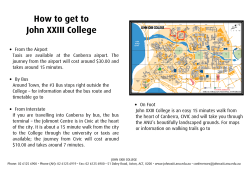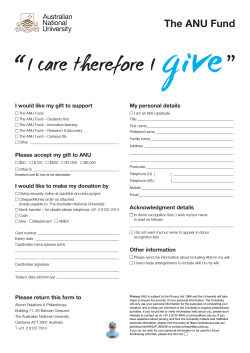
How to include people with chronic disease in community activities guide
How to include people with chronic disease in community activities Susan Abbott, Stefan Baku, Paul Dugdale, David Greenfield guide Published by ANU eView, The Australian National University, Canberra ACT 0200, Australia Email: anuepress@anu.edu.au This title is also available online at: http://eview.anu.edu.au A Catalogue-in-Publication entry for this title is available from the National Library of Australia Acknowledgements The development of this package was funded by the Commonwealth Department of Health and Ageing as an Interprofessional Learning in Primary Health Care to Encourage Active Patient Self-Management of Chronic Disease as part of an Australian Government Inter-professional Learning Chronic Disease Self-Management Demonstration project. in partnership with the Centre for Health Stewardship ANU, the Australian Capital Territory (ACT) Division of General Practice and ACT Health. The Chief Investigators of the project were Dr David Greenfield (UNSW), Associate Professor Paul Dugdale (ANU/ACT Health), Dr Jo Travaglia (UNSW), Dr Peter Nugus (UNSW) and Professor Jeffrey Braithwaite. Project The medical content of the guide was reviewed by the consultants of ACT Health and the ANU Medical School: Professor Leonard Arnolda (Cardiology), Associate Professor Christopher Nolan (Endocrinology), Dr Alexandra Hammett (Thoracic Medicine), Dr Rajeev Kumar (Psychiatry) and Dr Ling San Wong (Rheumatology). Input to the development and content of the guide was provided by staff from organisations and individuals in the ACT. The organisation were: the ACT Division of General Practice; ACT; Diabetes Australia ACT; Disability ACT; Heart Foundation ACT; OzHelp Foundation; Parkinson’s ACT; SHOUT Inc; Southern Cross Health Club; YMCA of Canberra; YWCA of Canberra; and volunteers from Health Care Consumers of the ACT and the ACT Chronic Conditions Alliance. This education package is supported by funding from the Department of Health and Ageing through the Sharing Health Care Initiative. © Copyright of the Centre for Clinical Governance Research in Health, University of New South Wales and the Centre for Health Stewardship, Australian National University, College of Medicine Biology and Environment, December 2010. May be reproduced if this ISBN 9780980728484 (print) 9780980728491 (ebook) For further information please contact <paul.dugdale@anu.edu.au>. Contents Acknowledgements ii Abbreviations iv Useful terms and definitions v 1 Introduction 1 2 Information on common chronic diseases and co-morbidities 3 Diabetes 4 Heart conditions 7 Chronic obstructive pulmonary disease 11 Musculoskeletal conditions 13 Depression 15 3 4 5 Duty of care 18 Privacy 20 Discussing chronic disease with a group activity participant 22 6 First aid 25 References 26 7 How to include people with chronic disease in community activities : a g u i d e iii Abbreviations ACTDGP Australian Capital Territory Division of General Practice AIHW Australian Institute of Health and Welfare Australian National University ANU CCGR Centre for Clinical Governance Research in Health COPD Chronic obstructive pulmonary disease IPCP Interprofessional collaborative practice IPL iv Interprofessional learning This symbol highlights first aid information in the text. How to include people with chronic disease in community activities : a g u i d e Useful terms and definitions Chronic disease A ‘term applied to a diverse group of diseases that tend to be long-lasting and persistent in their symptoms or development’ (AIHW 2006: 71). The main characteristics of a chronic disease as outlined by AIHW (2009) include: • complex causality • multiple risk factors • long latency periods • functional impairment or disability usually being confined to non-communicable diseases. When two or more diseases are present in an individual at the same time (AIHW 2007). The diseases can either have no association with each other or, more commonly, be directly related to each other. Examples include cardiovascular disease and diabetes, or health failure and depression. Co-morbidity Group leaders can be fitness instructors, experts in a specific activity and volunteers, qualified and unqualified. Group leaders The responsibilities of a group leader include: • having knowledge of the activity they are conducting • being aware of the special needs of participants • undertaking duty of care • providing an atmosphere that allows open communication between members and between the group leader and members. ‘… learning arising from interaction between members of two or more professions’ (Freeth et al. 2005). How to include people with chronic disease in community activities : a g u i d e Inter– professional Learning v Useful terms and definitions CONTINUED Physical activity The World Health Organisation (2009) has defined physical activity as ‘any bodily movement produced by skeletal muscles that requires energy expenditure’. Examples of physical activities include swimming, walking, yoga, exercise groups and gardening. The National Physical Activity Guidelines for Australians recommend that adults should ‘accumulate at least 30 minutes of moderate intensity physical activity on most, preferably all, days’ (DoHA 2009). Such activities will result in a noticeable increase in heart rate and breathing. The ‘active participation by people in their own health care’ (ACT Health 2008: 16), with support when needed from the health system. A person who is able to self-manage their condition understands their health condition, is able to make informed decisions about treatment, participate in the decision-making in relation to continuing care, have and follow a health care plan, monitor changes and are able to respond to changes through a pre-developed action plan (ACT Health 2008). vi How to include people with chronic disease in community activities : a g u i d e Selfmanagment
© Copyright 2025





















